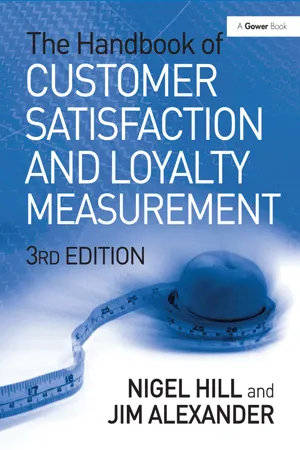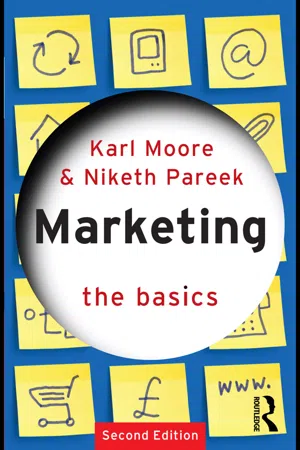Consumer Search
Consumer search refers to the process by which individuals seek out and evaluate information about products or services before making a purchase. This can involve researching online, seeking recommendations from friends or family, or comparing prices and features. Understanding consumer search behavior is crucial for businesses to effectively target and engage potential customers.
7 Key excerpts on "Consumer Search"
- eBook - ePub
- Mo Willan(Author)
- 2021(Publication Date)
- Bloomsbury Business(Publisher)
...CHAPTER FOUR Consumer Behaviour As explained in the first chapter, marketing is all about identifying and satisfying the needs of consumers, so understanding customers is crucial to marketing success. The Customer is King, so it is of critical importance that organizations devote significant time and resources to understanding their customers. It is essential to gain a solid understanding of what customers buy, why they buy, how they buy and when they buy. It is also crucial to understand the differences between consumers (users of the firm’s products) and customers (buyers of the firm’s products) because it can be the case that buyers are not always the users – it can be mothers who buy clothing for their children, for example. Consumer behaviour is the study of the decision-making process that consumers go through in their purchasing decisions. Companies need to ensure that they tailor their marketing activities and efforts to match the behaviours of consumers. The study of consumer behaviour involves both business-to-consumer (B2C) and business-to-business consumer markets (B2B). Business to consumer implies that the organization sells to individual consumers and business-to-business implies that the organization sells to other organizations. The Consumer Decision-Making Process (B2C) Consumers typically go through a number of distinct stages in their buying decisions, and this is known as the consumer decision-making process. The diagram below illustrates the different stages involved: Figure 5: Consumer Decision-Making Process Need or Problem Recognition The first stage of the decision-making process implies that the potential customer has a need or problem that is to be satisfied. This need can be brought about by internal factors such as hunger for food, or by external factors such as company promotions for its products...
- Nigel Hill, Jim Alexander(Authors)
- 2017(Publication Date)
- Routledge(Publisher)
...Companies and organisations must therefore understand what it is that drives a consumer to choose their particular product or service rather than that of their competitors. Car purchase may, for example, satisfy a need for transportation, a need for status, or a need for excitement. Organisations use promotional and selling techniques to position their product or service in the market in such a way that it will appeal to potential customers. Figure 6.1 The buying decision process of an individual purchaser INFORMATION SEARCH Once aware of a need or problem, an individual will set about solving it. Sometimes a problem is solved immediately: hunger is felt and a biscuit may be eaten. Sometimes the problem is more complex and the individual has to seek out information to help him or her solve it (see Figure 6.2). The first source of information most people turn to is memory. If you need a new exhaust for your car, your first thought will almost certainly be towards the solution of this problem the last time it arose. Who fitted the new exhaust? Was it all right? Was the service efficient? Was it reasonably priced? If your memory is favourable, that may be the end of it. You may skip the evaluation stage and make the decision to return to the same supplier as last time. There is a major implication in this for customer satisfaction measurement. An individual’s memory is often not a particularly reliable guide to what actually happened and subjective perceptions of events are usually not overburdened with the need to conform to reality. We often remember those things we choose to remember. In particular, we tend to remember bad, as opposed to good, experiences more vividly and for longer. Figure 6.2 Problem solving: the search for information But the individual customer will be quite happy with all this: his or her perception of events is reality and has to become reality for any supplier trying to sell goods or services to that individual...
- eBook - ePub
Strategic Marketing
An Introduction
- Tony Proctor(Author)
- 2002(Publication Date)
- Routledge(Publisher)
...The marketing strategist needs to identify the factors which give rise to the recognition of the problem and use these to advantage in marketing communications about the par ticular product, service or brand. Information search Once the problem has been recognized, prospective purchasers search for information about the product in question. A person who has recognized a need for a new hi-fi system, for example, may scan many hi-fi magazines for information on what is available and at what price. This scanning helps to identify locations where the products or service may be purchased and the intending buyer may well visit these locations to obtain more information and possibly to listen to a number of different hi-fi systems. The amount of search undertaken varies with individuals, the amount of time available and the availability of suitable products and services. From the marketer’s point of view, key interest is shown in the sources of information that the prospective purchaser will consult and the kind of information which is likely to sway the consumer into buying one particular brand over another. Evaluation of options There is an assumption that consumers make decisions on a conscious or rational basis, but this may not necessarily always be true. However, assuming a rational model of consumer choice, the process would seem to take account of the following: • Products are thought of as a bundle of attributes, e.g. bicycle: lightweight/heavy-weight, sports/touring, etc. • Relevant attributes vary from one product or service to another, e.g. size and speed are important with cameras whereas the variety and container are emphasized in the case of chocolates. • Some product attributes are more important to consumers than others, e.g...
- eBook - ePub
Strategic Marketing
An Introduction
- Tony Proctor(Author)
- 2014(Publication Date)
- Routledge(Publisher)
...Chapter 8 Analysing the customer in the market place INTRODUCTION The markets that are seen through strategic windows are not abstract concepts – they contain people. In order to understand how changes in the market occur, not only does an organization have to understand the broader issues in the business environment and the views of the market perceived by competitors, but it also has to understand the buying behaviour of the people themselves. In studying buyer behaviour, a distinction is made between complex decision-making situations and those in which little consideration is given to the purchase being made. Where a product is relatively expensive and possibly technologically complex, prospective purchasers often go through a complex search and evaluation process prior to making a purchase. Various models of consumer behaviour have been developed over the years. The models reflect the different buying situations in which consumers find themselves. Factors influencing consumer behaviour must be considered as well as similar factors influencing the buying decisions in business to business transactions. An understanding of these factors and how they influence the buying decision are extremely important when putting together a selling strategy (Exhibit 8.1)...
- eBook - ePub
- Karl Moore, Niketh Pareek(Authors)
- 2009(Publication Date)
- Routledge(Publisher)
...9 MARKET RESEARCH SEEKING DEEP INSIGHT INTO THE CUSTOMER’S WORLD AND MIND In Chapter 3 we discussed how marketers use segmentation, targeting and positioning (STP) to position their product. Underlying the STP process are hundreds of hours dedicated to data collection and analysis. This information is then used to gain a better insight into the customer’s mind and the world in which they live. Questions about the industry structure, the competition, economic trends, new advances in research and technology, shifts in consumer behaviour all fall under the rubric of market research. This chapter focuses on two main areas, first we look at the decision-making process a consumer goes through, we then investigate the different methods marketers use to collect market research. INTRODUCTION TO CONSUMER BEHAVIOUR In the previous chapters we talked about how marketers are responsible for communicating to the consumer the benefits of the product, and the differences between their product and their competitors’. Once the marketer has done so, it is the customer’s turn to respond. But how does the customer make a decision? The stimulus-response model illustrated in Figure 9.1 demonstrates how the process unfolds. Marketing and other stimuli from a buyer’s environment enters into a buyer’s mind. Once in the mind, which is essentially a black box, a number of transformations occur resulting in a response. Once a buyer absorbs information sent by the marketer, the buyer decision process begins. In general, the buyer decision process consists of five step. The first is need recognition. The buyer recognizes that a need exists. Then the buyer engages in an information search. At this stage, the buyer seeks information that enables her to make an informed decision. She relies on her own memory, the advice of friends, experts and advertising. The third stage is called the evaluation of alternatives stage. Here the customer weighs the possible pros and cons between available choices...
- Gideon Keren, George Wu, Gideon Keren, George Wu(Authors)
- 2015(Publication Date)
- Wiley-Blackwell(Publisher)
...However, consistent with the interdisciplinary underpinnings of consumer research, these papers largely take identity goals as given, investigating the processes consumers use to strive for or maintain desired identities through, in part, connections with brands. More generally, consumer research combines a wide variety of theoretical and methodological approaches to study the experience of the consumer. The rest of this chapter is organized as follows. First, I review some of the most longstanding topics of inquiry in consumer research to illustrate the historical roots of the field. Then, I illustrate more recent consumer decision making research from two perspectives both of which are chosen to highlight research that is relevant to understanding decision processes and outcomes and yet also relatively distinct in terms of being aligned with traditions from the broad and interdisciplinary field of consumer research. The first perspective explores a wide variety of social and emotional objectives that are relevant during consumer decisions. The second perspective explores a wide array of factors that influence how consumer decision makers process information in service of these objectives. Development of the Field of Consumer Decision Making Consumer decision making, like BDR, has intellectual roots in the tension between the normative economic and the psychological descriptive approach to decision behavior. Early work in consumer research identified and described a wide range of consumer biases following from factors such as interrelationships in the set of consumer products under consideration (e.g., Huber, Payne, & Puto, 1982; Simonson, 1989) or the presentation format for information in a store (Russo, 1977). Similar to concurrent work in BDR, early consumer research described the heuristics consumers used to go about decision making (e.g., Wright, 1975) and often emphasized prescriptive advice to decision makers (e.g., Bettman, 1975)...
- eBook - ePub
Entrepreneurship Marketing
Principles and Practice of SME Marketing
- Sonny Nwankwo, Ayantunji Gbadamosi, Sonny Nwankwo, Ayantunji Gbadamosi(Authors)
- 2020(Publication Date)
- Routledge(Publisher)
...Some of the key criteria that could be used are: Price; Quality; Convenience/Availability; Reliability; Comfort; Eco-Friendliness; Durability. It is important to note that the list is not exhaustive but more importantly, the criteria that will be used by the consumer will be a function of many factors, such as the nature of the product and the characteristics of the consumer. For instance, the criteria to use for the selection of which accountant to choose will be different from the one that will be used to select a web developer, which will also be different to what will be used when considering which restaurant to visit for a meal. While there is a challenge for small businesses in relation to large corporate organisations that are significantly endowed with resources, small businesses also have advantages in relation to niche targeting, closeness to their customers, and flexibility to make changes to explore marketing opportunities in the environment. Ultimately, the consumer develops a list of criteria that will offer her value in the transaction. The implication of this stage is quite significant for the SMEs. It is important to ensure that the business’ unique selling propositions (USP) is clearly highlighted to the consumers for them to be able to make it a choice among many when considering what to buy. PURCHASE Having evaluated the alternatives, the consumer decides to buy the one that offers the most value. Contemporary marketing is driven by value, which could be defined, from several aspects related to the transactions. The product itself is expected to be a source of value to the consumer in terms of how it fits the intended use. Price is another point of value. For example, it has been reported that consumers at the lower end of income spectrum are driven by price, buy no frills items, and do not consider higher prices to be indication of good quality (Gbadamosi, 2009). Similarly, the mode of distribution could be a source of value to the consumer...






